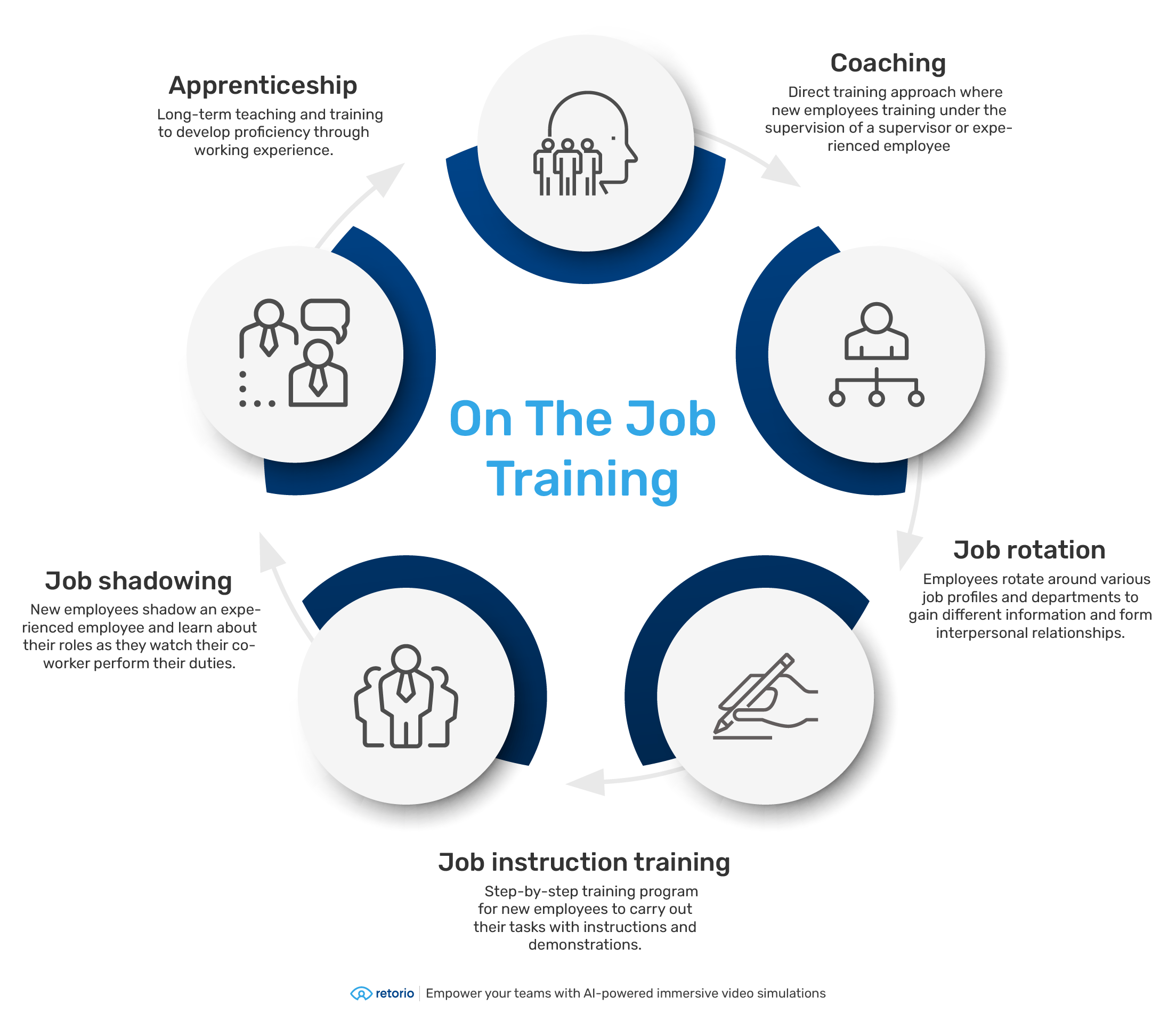Did you know that over 40% of employers voted that on-the-job training increases productivity and 35% of employers agreed that employee morale has been enhanced as a result of it?
With that being said, in today's highly competitive market, the majority of revenue an organization earns is generated through highly-trained and motivated employees.
However, the issue is that you may not always be able to hire well-trained employees or someone who has the exact set of skills that your company is seeking in a particular position. This is where companies turn to on-the-job training to fast forward the employee training process and ensure that new employees become fully equipped in their roles as they continuously take on new responsibilities.
Therefore, knowing which training process you would adopt is crucial. Otherwise, you may end up wasting time and resources trying to train employees with ineffective techniques, and more - potentially losing your competitive edge when employees begin to struggle with their tasks.
In this blog post, we will dive into the five best on-the-job training methods that will help your company gain that competitive edge and fast-forward your path to success.
As we all know - the better your assets are (your employees), the better your company performs.
What's in this post?
What is on-the-job training?
Instead of participating in training after an employee has settled into their new job, employees learn while they work. This is called on-the-job training, also abbreviated as OJT. It is essentially when employees learn about their workplace duties in a real-life situation rather than in a simulated environment.
In other words, it is a type of training that allows employees to develop practical skills in an actual work environment. For example, if a new employee starts working as a customer service agent, they can gain experience and new skills by job shadowing. This means that the new employee would observe a more experienced colleague for a period of time, and learn more about the role through the experience they gain while watching.
During on-the-job training, employees carry out their tasks and responsibilities with the guidance of practical aspects. It is also one of the employee training techniques that is most commonly used in companies as it is more immersive than off-the-job training.
This training method can be seen as a form of classroom learning. It takes place within a workshop at the company under the supervision of a manager or senior employee of the same department and allows new employees to become engaged in their learning process.
On-the-job training lets employees get a direct and unmediated experience of their work procedures. This helps them to be ready to face any potential challenges that come with their responsibilities and develop a mindset of continuous learning and growth. Employees will also gain a better understanding of what is expeqcted of them from their managers and team.
On-the-job training can last from a few weeks to a couple of months. It all depends on the nature of the work and how efficiently a new employee can gain new skills and become well-versed in their role.
71% of employees have voted on the job training to be their most preferred method of training.
On-the-job training methods
There are five main types of on-the-job training strategies that are used in companies.

Coaching
Coaching is a type of on-the-job training that involves a supervisor or an experienced employee to train a new employee how to do their job. It is a direct approach to training where employees are allowed to ask questions and receive guidance and constructive feedback on their performances.
Coaches often dedicate full-time to training employees which also helps companies to encourage employee retention.
You may also be interested in how your company can provide personalized coaching to successfully train your employees.
Job rotation
Job rotation is when an employee gains new skills and knowledge by switching between different roles. This form of training eliminates mundanity and helps employees develop strong interpersonal relationships with their colleagues across departments.
An example of job rotation in healthcare can be when a new nurse shifts between different ward positions, giving the new nurse exposure to the different challenges and experiences in caring for different types of patients. This way, the nurse also gets to build relationships with other nurses and learn from them.
This form of on-the-job training is useful as it allows the newcomer to develop a deeper understanding of the different aspects of the organization.
Job instruction training
Through job instruction training, the employee goes through a step-by-step training process with a trainer. The training involves a set of instructions and demonstrations for a specific task that employees will carry out. As with instructions, this training method begins with an overview of the job responsibilities and the expected outcome.
The training is then continued with a detailed description of the skills that the task requires each employee to have. Once the employee has completed their tasks and gained new knowledge, they will take part in a Q&A session with their trainer.
Job shadowing
"Watch, and learn."
One of the most commonly used on-the-job training methods is job shadowing. This workplace training method is where new employees observe a more experienced employee doing their job. For new employees, this method helps them to see what their job entails in real time.
This also benefits experienced workers who take part in job shadowing because it also helps them to learn new techniques, practice and develop their soft skills, and see the operation of their tasks from a potentially new perspective
Apprenticeship
An apprenticeship is when employees take part in a long-term learning process with their company. Specifically when it comes to industries in the field of arts, trade, or technology.
This is due to the high demand for expertise and proficiency they expect from employees which can be challenging to learn in a classroom. Therefore, an apprenticeship is a learning process that can last up to a couple of years (1-3 years).
Apprentices receive a structured training plan with a focus on mastering specific skills that the job requires. As a result, they spend at least 20% of their working hours gaining valuable experiences through a training program and completing different job assignments.
How on-the-job training methods give companies a competitive edge
The skills and competencies required for jobs are constantly changing. Therefore, it is the company's responsibility to bridge the skills gap and offer the right kind of training to their employees. Doing so will help employees advance their skills, enhance their capabilities, and cultivate new knowledge that will help them to thrive in their roles.
Companies that prioritize the development and expansion of the competencies and knowledge that their employees bring, experience a boost in productivity, and better work outcomes, and develop employees position themselves better in large business landscapes.
Moreover, on-the-job training encourages employees to build not only their proficiency but also on their level of self-confidence which is vital for professional and personal development. Confident employees become better at representing the company and its values and establishing valuable networking connections, thus increasing their contribution to the business's success.
Here are a few more ways how on the job training gives companies an advantageous competitive edge:
-
Boosts productivity: Due to the dynamic job landscape, it is crucial for employees to be trained and well-equipped on the usage of new technologies and their applications. Through on-the-job training and development, employees will be updated on industry trends, adopt modern technologies into their tasks, and leave the old ways of performing behind. As a result, employees will be able to complete tasks quicker and more efficiently and showcase improved work output as a result of the training. Moreover, as their productivity levels rise, their confidence will follow suit, enabling them to implement better ways to achieve their goals.
-
Encourages creativity: On-the-job training gives employees the chance to upskill, think outside the box to widen their strategic thinking abilities, sharpen their communication skills, and develop new skills that can put into action to improve your organization's competitive edge. This is also due to the engagement that comes with on-the-job training and is also an ideal opportunity to encourage innovation.
-
Helps tackle shortcomings: A great advantage that companies have to create a competitive edge through training is having multiple employees prove their excellence in different skills. However, every employee is bound to have shortcomings. Therefore, with the implementation of on-the-job training, organizations can immediately upskill employees to perform different tasks with the minimum skill level required. Additionally, on-the-job training plays a key role in helping companies close skill gaps, and keep employees on the edge of industry developments.
-
Increases employee morale: One thing that decreases employee morale is a lack of guidance and support. Especially when it comes to training programs. Through training and development programs such as on-the-job training, not only will the skills of employees increase, but so will their morale. This is due to the involvement, and the abundance of guidance employees will receive from experienced employees and supervisors as they step into their new role. Apart from eliminating the monotony in the workplace, on-the-job training allows companies to develop high-performing teams with high levels of collaboration and teamwork. This, in turn, boosts employee morale and job satisfaction, thereby improving retention rates.
-
Improves company reputation: When organizations provide employees with the right training programs, it makes the company stand out to potential candidates. Employees tend to select companies that are most likely to make them feel valued and know that their growth and development are something that the company will invest in. If a company shows its dedication to offering quality learning and development opportunities, employees will work harder to exceed expectations. This level of investment and dedication will be imprinted on your company's brand image and profile, which will make your organization a more sought-after workplace among job seekers.
Benefits of on-the-job training methods
On-the-job training offers a lot of benefits to the workplace. It provides companies with an immediate platform for gaining real-time experience and learning new techniques on the go. It also helps employees establish a clear routine and procedure on what is expected of them and helps them adapt to their new surroundings much more easily.
Below are a few more benefits:
| Benefit | Explanation |
|
Streamlined training with real-time experiences |
New employees often struggle to grasp the know-how of a workplace, their duties, and what their supervisor or manager expects of them. Amidst the struggle, they also may not know they can improve their performance levels. However, on-the-job training gives employees a clear idea of what their role is about, what their tasks entail, and how they can succeed in their role due to the guidance and continuous training they receive. As they work, they train, and as they train, they learn quickly and efficiently to become masters at their job.
|
|
Retain top-performing employees |
Every organization benefits greatly from employee retention. This is possible when employees become well-versed in their responsibilities and performance expectations. Why? because when employees are uncertain about their duties, they are more likely to become stressed and unproductive, which can result in poor management and lead to overall inefficiency.
Several on-the-job training methods help employees avoid this by allowing them to learn about their jobs every day. This process incorporates employees well into their roles and helps them to feel like they are part of the organization.
|
|
Attract the right candidates |
Not only does on-the-job training retain top talent, but it also helps your company attract top candidates by serving as a filter for companies to identify qualified candidates for a job position. On-the-job training assesses a candidate's capabilities and encourages motivated employees to improve their performance. Therefore, employees with a stronger potential for great performance can spend more time developing more skills and competencies during the training period.
|
|
Financial benefit |
On-the-job training is first and foremost, cost-efficient. This is because companies do not need to take out time for training as it takes place in everyday workplace training. Therefore, companies can boost efficiency without having to spend extra costs on training sites or external coaches or mentors.
|
Interested in the other benefits that on-the-job training has to offer? You may be interested in our related blog post about the eight benefits of on-the-job training.
On-the-job training with Artificial Intelligence
On-the-job training plays a big role when it comes to creating positive, and effective onboarding experiences. This is especially the case for customer service. When it comes to optimizing call center onboarding procedures and getting new employees well-equipped to provide exceptional customer support, getting the right training is important to ensure great results.
The challenge here is that there is sometimes a lack between real-life experiences and real-life training experiences. When customer service agents practice client calls during training, they may still feel hesitant during real client calls. This is due to the lack of hands-on experience that helps employees reach a sufficient experience level faster.
However, there is a solution to that. The answer is Artificial Intelligence.
Retorio's AI-powered behavioral intelligence platform enhances the onboarding process for customer service teams to allow employees to gain more practical training time during their onboarding. This has helped companies increase the success rates of new hires, elevate the proficiency level of newly hired call center reps, and improve their overall customer satisfaction rates.
During the training, trainees become immersed in AI-generated role-play simulations that bring hands-on experience to them, only virtually. The behavioral intelligence platform offers different customer call interactions with different inquiries, allowing individuals to experience numerous real-life scenarios that they are likely to face in their role.
Once AI has analyzed, and understood the behavior from the video response, it provides trainees with personalized feedback based on their performance and receives detailed insights into how the trainee's response matched the desired outcome of the organization. The feedback not only includes comments on the trainee's behavior, but also dives into the trainee's communication style, facial expression, body language, and tone of voice.
|
Without Retorio
|
With Retorio
|
|
Training efficiency enhancement
|
|
|
26 hours per new hire
|
8 hours per new hire
|
|
Accelerated speed to competency
|
|
|
8 weeks
|
5 weeks
|
|
Cost savings with increased productivity
|
|
|
Newly onboarded hires make 600 calls in the first week.
|
Newly onboarded hires make 720 calls in the first week.
|
|
ROI maximization with increased productivity
(A new hire in India costs approx. EUR 5570, and EUR 2900 in Egypt.)
|
|
|
Approx. 150 new hires start in India, and 100 in Egypt, monthly.
|
With a shorter ramp-up time and maximized productivity, a total saving of 800,000 annually.
|
This modern training approach allows companies to facilitate on-the-job training effectively and easily, with AI-powered simulations providing trainees with the opportunity to speak freely and confidently during their sessions, respond to scenarios in a psychologically safe space without fear of judgment, and actively absorb knowledge.
AI-powered training creates an enjoyable, and efficient training environment for each individual where everyone experiences a strong sense of engagement and immersion without unnecessary external trainers or influences.
With Retorio, you can enhance your training efficiency by reducing the time spent on training each new hire from 26 hours down to only 8 hours, and accelerate your competency achievement speed from 8 weeks to 5 weeks.
Don't wait any longer to get started! It only takes a click of a button to boost your training!
FAQ
On-the-job training immerses employees in their duties and responsibilities through practical application, while mentoring focuses more on the employee's goals, and challenges through a one-on-one conversation. On the job training occurs simultaneously with an employee's work responsibilities, while mentoring typically takes place outside of working time.
A potential disadvantage of on-the-job training is the lack of theory. Due to on the job training behind hands-on, it might not equip new employees to understand the theoretical aspects of their tasks. This lack may cause employees to adapt more slowly to new roles, or to understand issues that occur outside of their daily tasks.



